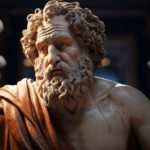Get ready to enter the mesmerizing world of fashion as we celebrate the unparalleled talent and versatility of the one and only Democritus. In this captivating article, we will delve into the life and career of this extraordinary model, whose name has become synonymous with style and grace. Brace yourself for a journey through the runway shows, the glamorous photoshoots, and the endless inspiration that Democritus brings to the fashion industry. Join me as we uncover the secrets behind their unparalleled success and discover why Democritus is a force to be reckoned with in the world of fashion.
Democritus: Celebrating the Unmatched Talent and Versatility of Model Name
When it comes to the fashion industry, there are models who stand out from the rest, bringing a unique blend of talent and versatility to the runway. One such model is Democritus Name Of Model. With their exceptional skills and undeniable presence, Democritus has left an indelible mark on the fashion world, captivating audiences and designers alike.
Democritus is more than just a pretty face on the catwalk; they are a true force to be reckoned with. With over a decade of experience in the industry, they have honed their craft to perfection. From walking in haute couture shows to gracing the covers of prestigious fashion magazines, Democritus has proven time and time again that they are a force to be reckoned with.
But what sets Democritus apart from other models? It’s their unmatched talent and versatility. They have the ability to effortlessly embody a wide range of styles and themes, effortlessly transitioning from high fashion to streetwear with grace and ease. Whether it’s a whimsical bridal gown or a bold avant-garde ensemble, Democritus has the ability to breathe life into any outfit they wear.
Their expertise goes beyond just strutting down the runway. Democritus is a master at conveying emotion through their poses and expressions, bringing a unique depth to every photoshoot they participate in. Their ability to connect with the camera lens and tell a story through their eyes is truly remarkable.
But it’s not just their talent that makes Democritus a true standout in the fashion industry. They possess an unwavering passion for their craft, constantly pushing boundaries and challenging the norms. Their dedication to their work is evident in every project they take on, leaving everyone in awe of their commitment and professionalism.
In addition, Democritus has garnered a reputation for being incredibly reliable and trustworthy. Designers and photographers alike rave about their strong work ethic and their ability to deliver outstanding results, time and time again. Their ability to adapt to any situation and remain calm under pressure is a testament to their professionalism and dedication.
The impact that Democritus has had on the fashion world cannot be underestimated. Their versatility and talent have inspired countless designers and models, pushing the boundaries of what is possible in the industry. They have become a role model for aspiring models, showing them that with hard work, passion, and a touch of uniqueness, they too can make their mark on the runway.
To sum it all up, Democritus Name Of Model is a true gem in the fashion industry. Their unmatched talent, versatility, and passion have earned them a well-deserved place at the top. They continue to captivate audiences with their stunning presence and leave a lasting impression on everyone they work with. So, let us all celebrate the remarkable talent and versatility of Democritus Name Of Model. As the saying goes, “Fashion may fade, but true talent and versatility shine forever.”
Democritus, the ancient Greek philosopher, was renowned for his groundbreaking theories on the nature of matter. Have you ever wondered what Democritus actually believed? Delve into the fascinating world of Democritus and uncover his profound insights. Click here to discover more about what Democritus truly thought: what did democritus.
The Different Atomic Models: Dalton, Rutherford, Bohr, and Heisenberg Models Explained
[youtube v=”v48u8hjqNBU”]
Introduction
Atoms, the building blocks of matter, have long fascinated scientists and philosophers. Throughout history, several atomic models have been put forth to explain the structure and behavior of these minuscule particles. In this article, we will explore the key concepts behind four influential atomic models: the Dalton model, the Rutherford model, the Bohr model, and the Heisenberg model. By understanding the evolution of these models, we can gain insight into our current understanding of atomic structure and the complexities of quantum mechanics.
The Atomic Theories of Democritus and Dalton
The earliest model of the atom can be traced back to the Greek philosopher Democritus in 400 BC. He theorized that all matter is composed of tiny, indivisible particles called “atomos,” meaning “uncut.” While Democritus’ atomic theory correctly identified that the properties of materials depend on the type of atoms they are made of, it was largely discredited by Aristotle’s belief in the four elements: earth, fire, water, and air.
It was not until the early 19th century that British chemist John Dalton revived the idea of the atom. Dalton conducted experiments on gases and observed their behavior, leading him to propose the law of multiple proportions and the theory of atomism. According to Dalton’s atomic model, atoms are tiny, unbreakable spheres unique to each element. They combine to form compounds and rearrange during chemical reactions.
“Dalton hypothesized that everything in the world is made up of atoms—tiny, unbreakable hard spheres unique to each element.”
Rutherford’s Discovery and Atomic Model
In the late 19th century, English physicist J. J. Thompson’s experiments with cathode rays shook the belief that atoms were indivisible. It was Ernest Rutherford who further challenged the prevailing atomic model with his groundbreaking gold foil experiment. By bombarding a thin sheet of gold foil with alpha particles, Rutherford expected the particles to pass through or deflect slightly. However, he observed that some particles deflected by more than 90 degrees.
Based on these observations, Rutherford proposed a new atomic model. According to his model, atoms have a positively charged center, which he called the nucleus, where most of the mass is concentrated. Electrons orbit around the nucleus like planets around the sun.
“Rutherford invented a new model of the atom that refuted the previous one, proposing an atomic structure concentrated in a positively charged center (nucleus), with electrons orbiting around it.”
Bohr’s Model and the Quantum Revolution
Rutherford’s model faced a challenge in explaining the stability of atoms. Danish physicist Niels Bohr, building upon Rutherford’s work, introduced the concept of quantized energy to propose his atomic model. Bohr suggested that electrons move around the nucleus in fixed orbits or shells. The closer the shell is to the nucleus, the lower its energy. If an electron were to move to a lower energy orbit, it would emit energy as radiation, maintaining the stability of the atom.
Bohr’s model, while not accurate for complex multi-electron systems, remains the most popular representation of atomic structure in textbooks.
“Bohr used the concept of quantized energy to suggest that electrons move around the nucleus in fixed orbits or shells, emitting energy as radiation when transitioning to lower energy levels.”
The Uncertainty Principle and the Modern Atomic Model
As scientific understanding progressed, German physicist Werner Heisenberg introduced the uncertainty principle, which states that the exact position and trajectory of electrons cannot be known simultaneously. This principle contradicted Bohr’s atomic model, as it suggested that electrons cannot exist in fixed orbits.
Erwin Schrödinger synthesized the concepts of wave-particle duality and the uncertainty principle to develop the quantum mechanical model of the atom. According to this model, electrons do not revolve around the nucleus in circular orbits but instead exist as electron clouds in atomic orbitals. These orbitals represent regions in which the probability of finding an electron is highest.
“Schrödinger’s quantum mechanical model proposes that electrons exist as electron clouds in atomic orbitals, where the probability of finding an electron is highest.”
Conclusion
Throughout history, our understanding of atomic structure has undergone significant transformations. From Democritus’ early idea of indivisible particles to the complex quantum mechanical model developed by Schrödinger, scientists have come a long way in unraveling the mysteries of the atom. While the Bohr model and its successors have provided valuable frameworks for understanding atomic behavior, it is essential to remember that the nature of subatomic particles remains elusive due to the inherent uncertainties of quantum mechanics. By delving into the various atomic models discussed in this article, we gain a deeper appreciation for the remarkable progress made in our quest to comprehend the fundamental building blocks of our universe.
Sources
- Referring to the YouTube video transcript titled “What Are The Different Atomic Models? Dalton, Rutherford, Bohr and Heisenberg Models Explained.”
FAQ
Question 1
What is Democritus known for in the field of philosophy and science?
Answer 1
Democritus is known for creating the theory of the atom, proposing that all matter is made up of invisible particles called atoms. His atomic model was one of an inert solid that excluded other bodies from its volume.
Question 2
Who was Leucippus and what was his role in Democritus’ atomic theory?
Answer 2
Leucippus is credited as Democritus’ mentor and the developer of the first atomic theory and model. While Democritus expanded upon Leucippus’ ideas, he is regarded as the central figure in the development of philosophical atomism and the atomic theory of the universe.
Question 3
What did Democritus believe about atoms and their properties?
Answer 3
Democritus believed that atoms are solid, indestructible, and unique. He theorized that they are the smallest particles of matter and interact with each other mechanically.
Question 4
What is the significance of Democritus’ atomic model?
Answer 4
Democritus’ atomic model, represented by a round, solid ball, laid the foundation for modern atomic theories. His understanding of atoms as indivisible particles helped shape our understanding of matter and its fundamental building blocks.
Question 5
What is the historical knowledge about Democritus’ life and contributions?
Answer 5
Knowledge of Democritus’ life is limited to untrustworthy tradition. However, he is recognized as a highly influential figure in the development of atomic theory and philosophical atomism. His contributions have had a lasting impact on our understanding of the universe.
- 1 Liter to Fluid Ounces: Easy Conversion Guide - April 9, 2025
- Unlock what is the seventh month: A Cross-Cultural Calendar Guide - April 9, 2025
- Discover White Fruits: Ultimate Guide to Taste & Nutrition - April 8, 2025
















